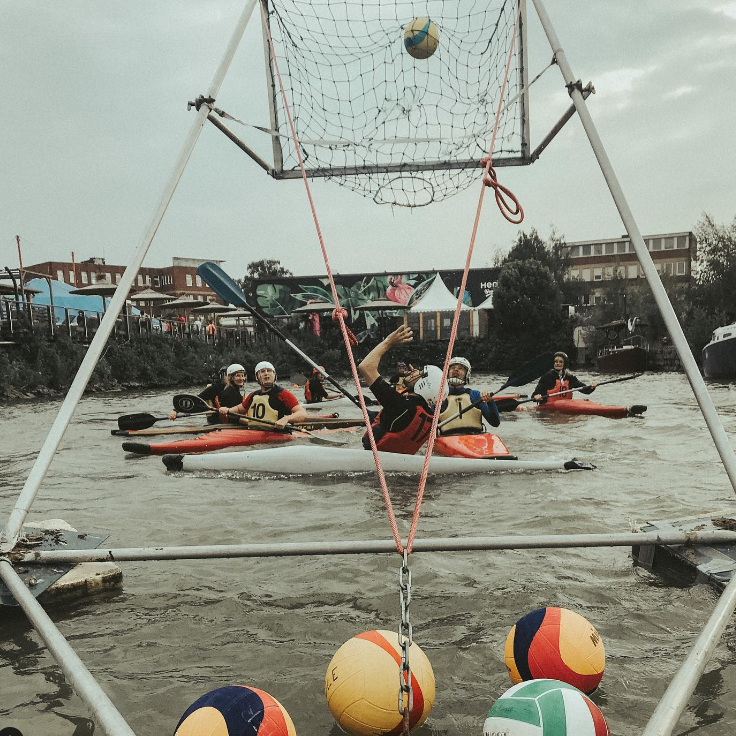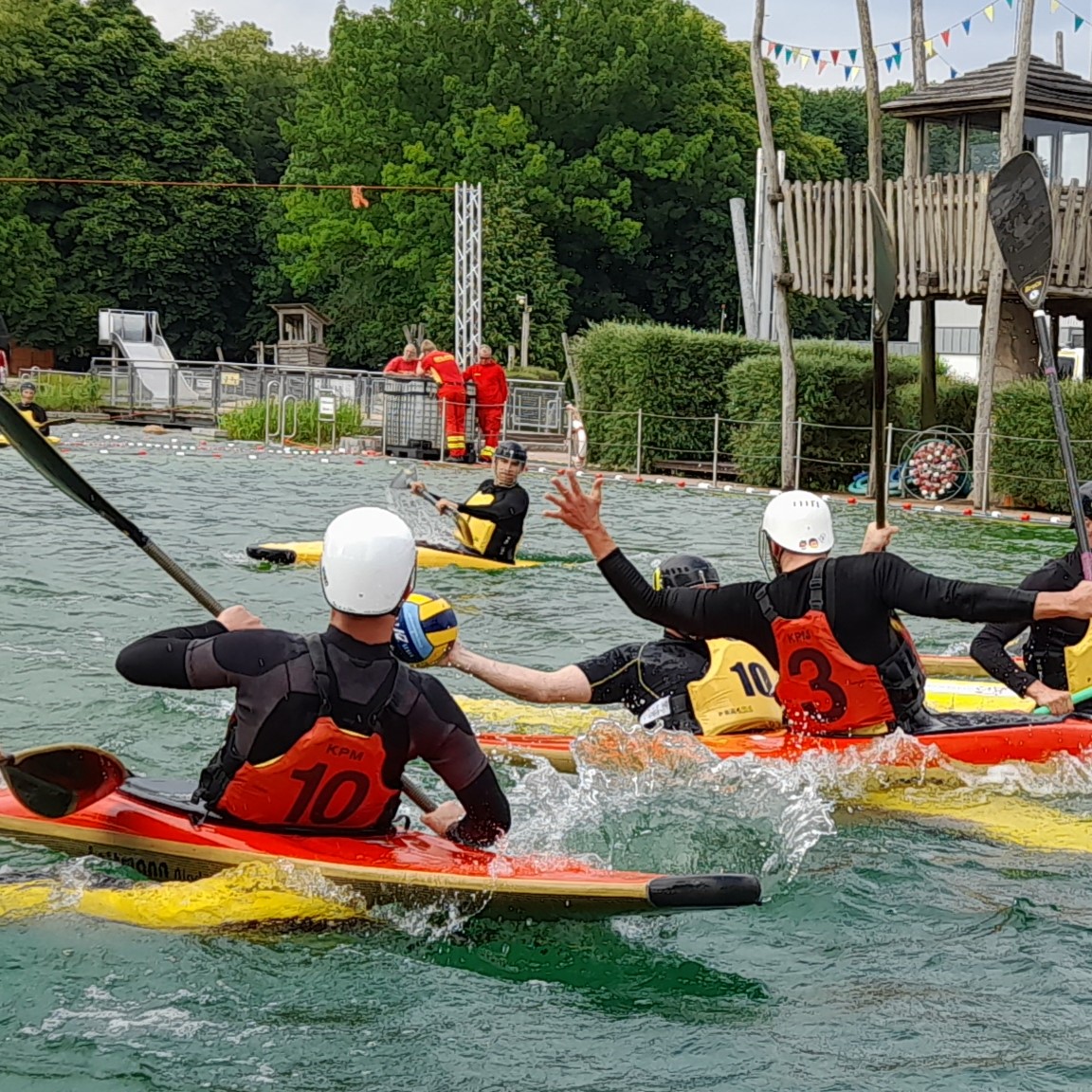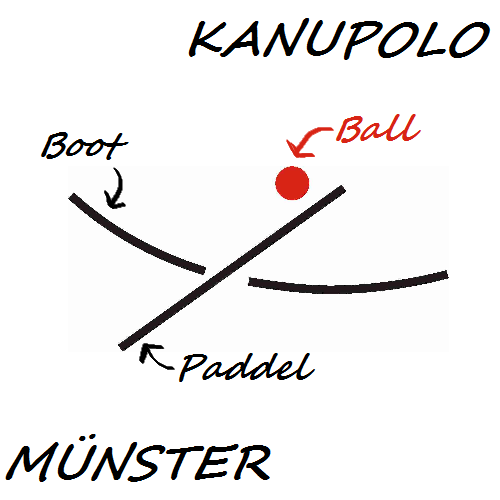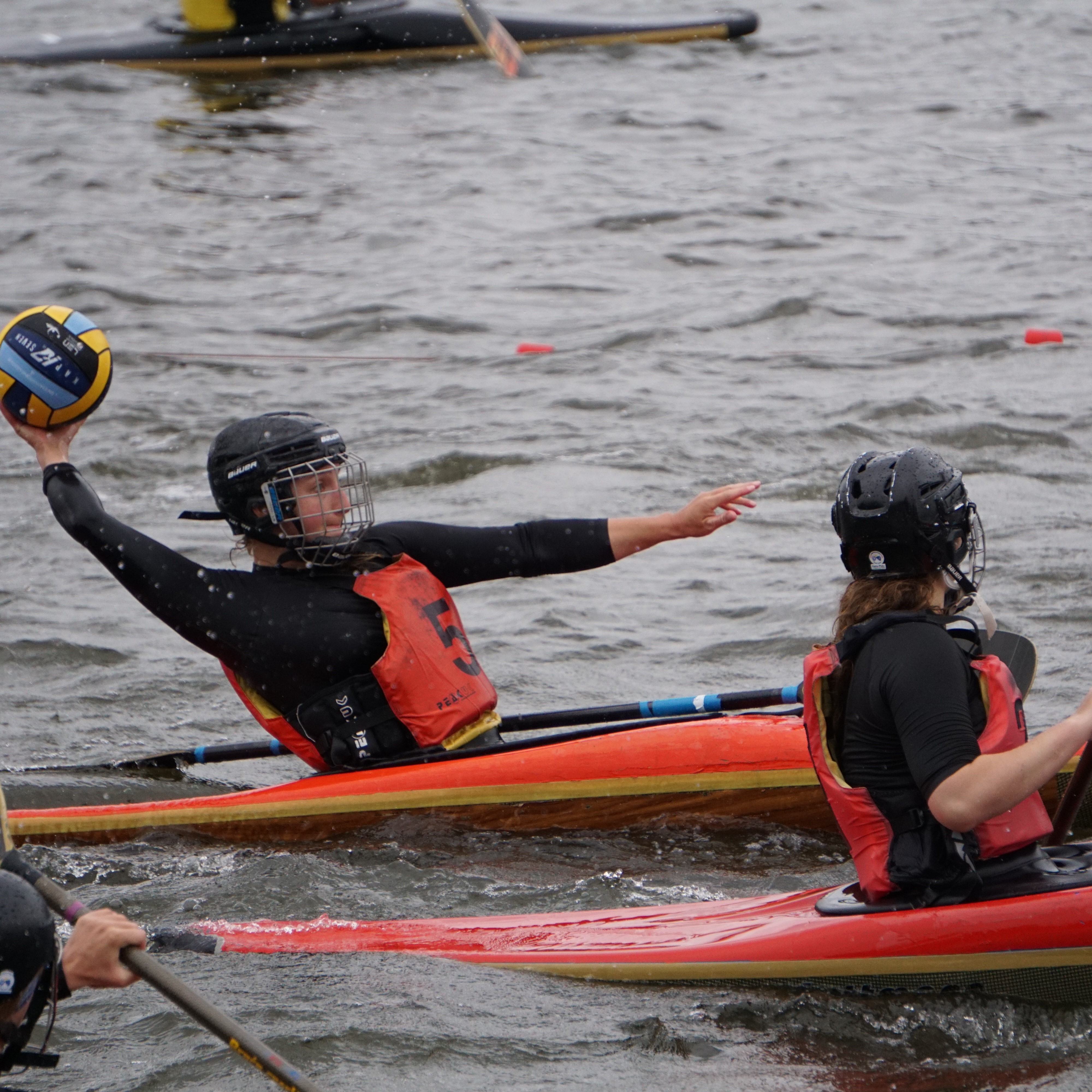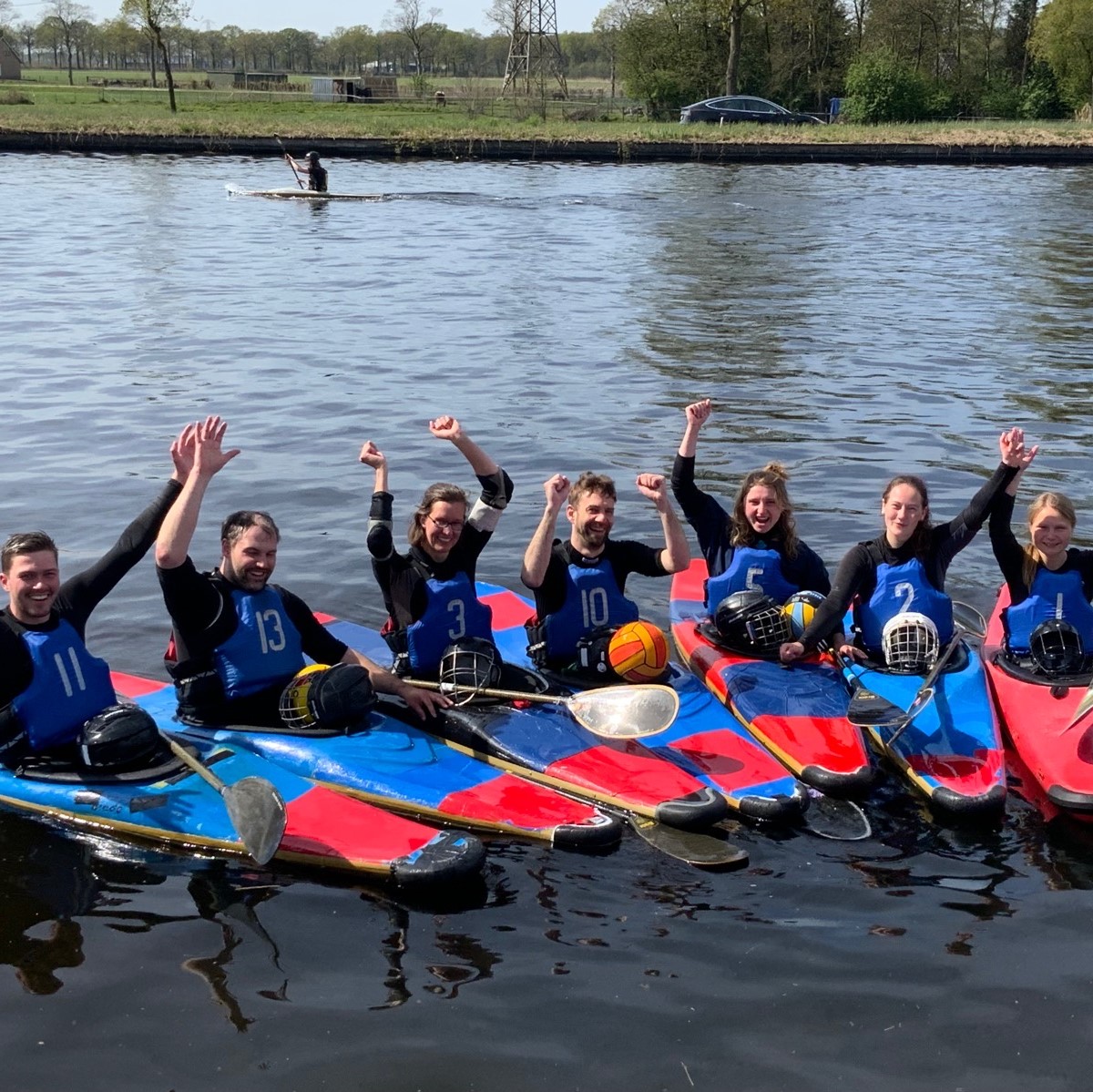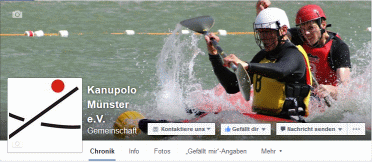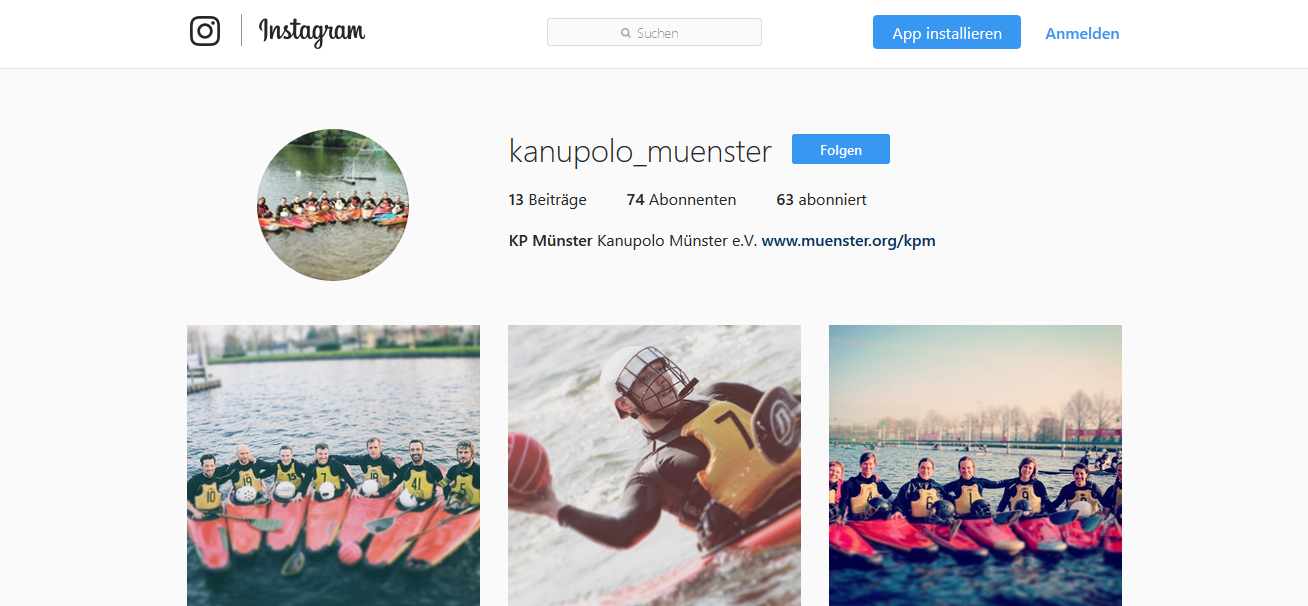Der nachfolgende Artikel ist auf der Homepage der International Canoe Federation erschienen und unter folgendem Link abrufbar (Stand 6/2016): http://www.canoeicf.com/boat-paddle-and-ball
Und für alle visuellen Typen: Die Finals der Weltmeisterschaft 2018 in Kanada mit deutscher Beteiligung auf youtube.
"Boat, Paddle and Ball"
A Short History of Canoe Polo - by Ian Beasley
Today’s canoe polo is power, speed, athletic and spectacular; contrasting to the relaxed recreational canoe ball games of the past. The birth of the modern sport can be considered the demonstration games at Duisberg, Germany in 1987. But for over 100 years before this, canoeists played games of boat, paddle, and ball.
Beginnings
Early magazines record that a variety of canoe ball games were played in Great Britain in the late nineteenth century. Punch, or the London Charivarl, published a woodcut entitled ‘Polo on the Sea’ in 1875. The picture shows men and women in neck- to-knee bathing costumes standing on flat topped, double-hulled vessels competing for the ball with double bladed paddles. The objective appears to be to place the ball into a floating ring. The Graphic, also of London, published an engraving in 1880 entitled ‘Water Polo at Hunter’s Quey, Scotland’. This is quite different; players sit astride wooden barrels made-up with horses’ heads and tails. Simply staying on the horse was challenging enough as riders were thrown from their uncooperative charges. Another picture, ‘Water Polo’, from The Graphic in 1884, shows players in decked canoes. The same picture appears in the book Outdoor Games and Recreations–a popular encyclopedia for boys published by the Religious Tract Society in London, 1892. The fun continued into the 1950s with two players to a canoe; one to paddle and the other to play the ball. These early games were a novelty, about fun and entertainment, and did not develop into today’s canoe polo (1).
Around this time, canoe polo was also played in the United States of America. The first game was at Rocky Glen, Pennsylvania in 1905. John Conkling designed a boat specifically for playing canoe polo on a field marked out by a timber frame (2). At Williamsport, 1913, players, one to a canoe, stood to work the ball with a paddle. And at Pittsburgh a Canoe Polo League was established in 1914 with clubs competing for a championship trophy. The playing area was 15m x 45m with goal posts at each end, the boats were 4.8m long. A game comprised in two 10 minute halves. The paddles had a metallic spoon ring fixed to each blade that formed a pocket to catch and carry the ball (in the manner of lacrosse). In 1916, New Jersey, each team consisted of five players, the boats were 1.8m long and a game was three 15 minutes innings; the ball was 15 cm diameter. Different games were introduced to Texas and Illinois. In Texas, 1922, a team comprised upto five canoes with a single paddler. While in Illinois, 1923, there were three canoes, each with two players. Newspapers reported canoe polo as a fast and attractive sport for players and spectators. But it was not to last. From the 1930s, the sport appears to have lost its appeal and was not active again in the USA until the late 1990s.
In the 1920s, Germany and France played canoe ball games as an introduction to canoeing and to build river skills. Serious canoeists paddled remote rivers but as the automobile was not yet widely available, only the most enthusiastic ventured out. It was difficult to attract new paddlers and spectators were few. Canoe ball games provided an exciting introduction to canoeing: challenging, safe, and close to home.
In 1926 the German Canoe Federation introduced ‘kanupolo’ as a way to attract new members as well as encourage camaraderie and contribute to federation finances. They also published rules of play. Folding kayaks were used until the 1930s but later replaced with wooden boats that were over four metres long. The playing area was large, 99–120m long by 50–90m wide. Goals sat on the water and were 4 m wide by 1.5m high. Each team had eleven players and a game was in two halves of 45 minutes each. The playing field was later reduced to 60–90m x 40–60m with two 30 minute halves and five players aside. By 1935 kanupolo had become a regular competition with a governing body, coaching manuals, and consistent rules of play. There was a break during war years with interest not renewed until 1965. Regular competitions resumed 1969.
The Canoe Club of France introduced canoe ball games to canoeing festival programs in 1929. The games soon developed into a sport with a playing area of 60–100m long by the width of the river. Goals sat on the water and teams comprised three, four or five boats. In 1935 a group of paddlers set guidelines for a game called ‘canoe ball’ to be played at the festivals—its primary aim was to vary training and to test paddling skills. It was not intended to create a competitive sport, although by 1943 playing rules were formalised, the large playing fields were reduced to 80m x 35m, kayaks replaced canoes, and canoe ball became ‘kayak ball’.
Great Britain continued with two to a canoe until the 1950s. Following Great Britain, Australia took to touring canoes with two players from 1952 through to the 1970s. The bow paddler played the ball while the stern paddler controlled the boat. But change was coming. In 1960, Oliver Cock refereed a game played in canvas canoes on a lake in Northern Wales, one player to a boat.
For many years canoe polo had been played on rivers and lakes in a variety of craft, on different sized fields, to different rules, under different names, and for different reasons. There was little need to change what was an enjoyable and challenging activity.
Technology
Quite independently, in 1966, the Borough of Newham in London asked Bert Keeble from the National Schools Sailing Association to design a kayak for teaching in swimming baths. Many pools were built in schools in the sixties and used for teaching children basic paddling and rolling skills. Ball games were a part of these sessions that provided an entertaining and practical way to apply the new skills. Some pools were open to the public. The pools were small, 10m x 25m, so small kayaks were needed to make the best use of the available space. The new kayak was made from wood; it was short and had a rounded bow and stern to prevent damage to the pool. Later, Alan Byde, a senior coach with the British Canoe Union (BCU), constructed a similar one from glass reinforced plastic. He called his boat the baths advanced trainer (BAT).
The move to a baths setting and the creation of the BAT together provided the impetus to reshape the sport: the pool limiting the size of the playing area and the smaller boat leading to a more maneuverable craft. There were few rules of play, but these would change too.
Taking shape
An international competition beckoned. An enthusiastic following had grown through the schools in England and canoe polo played in swimming baths was an emerging national sport. It was introduced as a demonstration sport at the Crystal Palace Exhibition, London in 1970 and caught the imagination. Such was the interest that the first English National Championships were held at the National Canoe Exhibition in the following year. Subsequently, the championships were held every second year and over several years, introduced the English version of canoe polo to the world. By the end of the 1970s England, Germany, France, Australia, Finland, Hong Kong, the Netherlands, Sweden, Denmark, Italy and Spain played some form of canoe polo.
Oliver Cock, a national coach with the BCU, had written the rules for the 1970 Crystal Palace games that called for a 1m x 1m target suspended 2m above the water at each end of the field and, along with other requirements, prohibited playing the ball with the paddle. At the first English National Championship in 1971, a school team (average age 16 years) lost the grand final. They were incensed because aside from inconsistent refereeing, the paddle rule was not consistently applied and consquently penalised their style of play. They complained to the BCU, which in response, formed the BCU canoe polo committee with an intial brief to formalise the rules.
In 1972 the committee moved to introduce these to other countries, but met considerable opposition. Consequently two quite different games persisted with the supporters of each passionately defending their favoured style. England, France and Australia preferred the BCU format of 1m x 1m goals 2m above the water and allowing hands to play the ball. Germany, Italy and the Netherlands preferred the large playing area, on water goals, using the paddle to control the ball. Germany continued playing on large playing areas until 1990.
Seeing the need for a uniform approach, the International Canoe Federation (ICF) published a universal version of the playing rules, also after much debate over which form the game should take, in 1986. The first demonstration of these was at the World Sprint Titles in Duisberg in 1987, arguably the birth of the modern game. The sport of canoe polo was now official. It is played on a smaller field, with elevated goals, the ball may be controlled by hand or paddle, and the BAT is the designated boat.
An international sport
The ICF International Canoe Polo Rules were finalised in 1990—playing area 30m x 20m (later revised to 35m x 23m); goals 1.5m x 1m, 2m above the water and playing time two, 10 minute halves. The inaugural ICF World Canoe Polo Championships held at Sheffield, England in 1994 showcased the sport with eighteen competing countries. There were eighteen mens teams and six womens teams. The countries and their final placing were, for the men: 1 Australia, 2 Germany, 3 Great Britain, 4 Netherlands, 5 France, 6 Belgium, 7 Ireland, 8 Hungary, 9 Italy, 10 New Zealand, 11 Chinese Taipei, 12 South Africa, 13 Finland, 14 Austria, 15 Japan, 16 Brazil, 17 Portugal, and 18 Canada. And for the women: 1 Australia, 2 Great Britain, 3 France, 4 Germany, 5 New Zealand, and 6 Ireland. Subsequent championships were hosted by Australia (1996), Portugal (1998), Brazil (2000), Germany (2002), Japan (2004), The Netherlands (2006), Canada (2008), Italy (2010), Spain (2012) and France (2014). A new milestone was reached in 2005 when canoe polo returned to Duisberg for the multi-sport 2005 World Games.
Canoe polo demands speed, skill and teamwork; a spectator’s delight. Tackling, ball skill and boat skills make it very different. Now a sport in its own right, it is no longer simply river entertainment or a diversion for the other disciplines.
Close
Far from the relaxed recreational games of yesteryear, canoe polo has become a fast competitive sport that challenges the best sportsmen and sportswomen. It has taken shape over the years and continues to change. But above all, the origins of the sport are not lost: most still play for fun.
Acknowledgements
The author wishes to acknowledge the various sources that have provided the material for this history. Along with the references given below, many players have shared their recollections of the game’s changes over recent years. The Internet has been invaluable; providing access to archived newspapers and newsreels, club histories and other groups around the world. Thank you everyone. Comments on this essay are welcome and should be addressed to the author at:
References
British PATHÉ newsreels archives available on YouTube:
1938 – Marlow Regatta, England
1949 – River football, England
1966 – Kayak football, France
1970 – Bat polo, England
Byde A, Beginner’s Guide to Canoeing, Pelham Books, 1974. Byde A., Living Canoeing, 3rd edition, A&C Black, 1979.
Canoe polo history, International Canoe Federation, www.canoeicf.com/cpolo/history.php.
Cock O J, A Short History of Canoeing in Britain, British Canoe Union.
Conkling J F, Boat, United States Patent Office, patent number 803272, October 31, 1905.
Conkling J F, Water-polo apparatus, United States Patent Office, patent number 814674, March 13, 1906
Geschichte des kanupolo, Deutsche Meisterschaften, vom 2, 5 September 2004, www.krm-essen.de
Hignell R, Bristol Canoe Club, firsthand account on the creation of the English rules of play, email June
2006.
Histoire du kayak polo, Monitgny en Gohelle, 4 June 2000. McCarthy R H, Canoeing, Sir Isaac Pitman & Sons, London, 1940.
www.newspapers.com – American newspaper archives 1700s – 2000s.
Conkling J F, Water-polo apparatus, United States Patent Office, patent number 814674, March 13, 1906
Geschichte des kanupolo, Deutsche Meisterschaften, vom 2, 5 September 2004, www.krm-essen.de
Hignell R, Bristol Canoe Club, firsthand account on the creation of the English rules of play, email June
2006.
Histoire du kayak polo, Monitgny en Gohelle, 4 June 2000. McCarthy R H, Canoeing, Sir Isaac Pitman & Sons, London, 1940.
www.newspapers.com – American newspaper archives 1700s – 2000s.
Endnotes
1 Many people wonder how a sport played in kayaks gained the name ‘canoe’ polo instead of ‘kayak’ polo. In late nineteenth century England, canoes were considered boats in which the paddler sat low and faced the direction of travel (compared to a row boat in which the paddler sat high with their back to the direction of travel). Canoe conveniently described a variety of craft that included Canadian canoes, Eskimo kayaks, kayaks, decked canoes, folding canoes, and the Rob Roy. Early games were played in canoes and kayaks, so canoe polo was an easy and logical name for the sport. The Rob Roy is of interest because it was possibly the first example of a decked canoe that would today be called a kayak. John MacGregor constructed a deck on a canoe, which he called the Rob Roy, to paddle Europe’s rivers; he also used a double bladed paddle. A description of the boat and his adventures are given in his book A Thousand Miles in a Rob Roy Canoe published in 1866.
2 John F Conkling of Hawley, Pennsylvania applied for two patents with the United States Patent Office that relate to canoe polo. The first in 1905 was for a collapsible canoe designed for playing water or canoe polo. The boat was 183 cm long x 61 cm wide. The second in 1906 was for a water-polo apparatus intended to mark-off a playing field. The field was 48.8m x 24.3m wide, the frame included goals and a method for placing the ball in the centre of the field. What became of Conkling’s inventions and their influence is not known.
